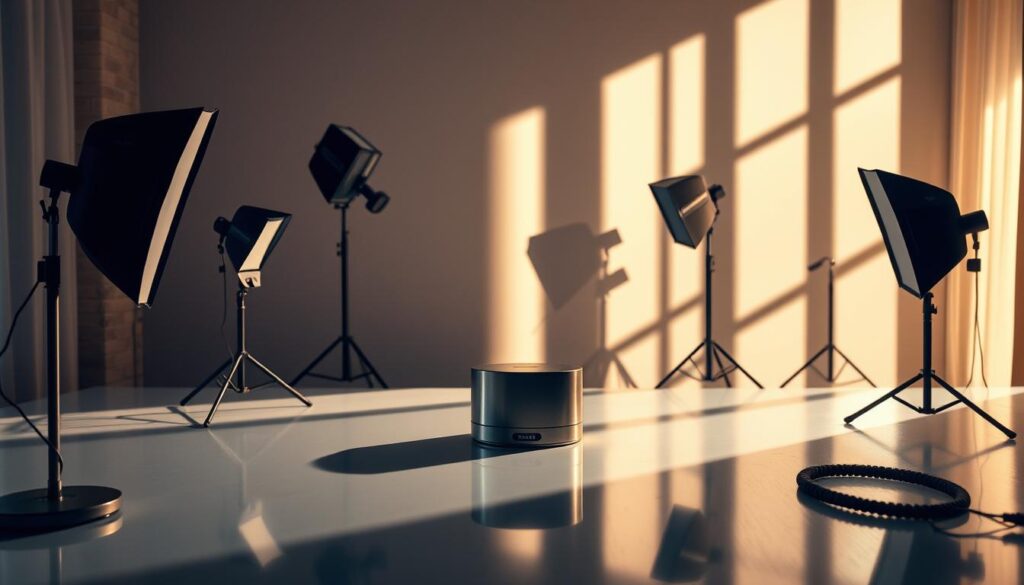As an entrepreneur, you know how important visuals are today. what is Product photography can make your brand shine, attract customers, and boost sales. But, where do you start? This guide will show you how to take amazing product photos that grab your audience’s attention and improve your online look.
Key Takeaways:
- Product photography is key to showing off your products and gaining customer trust.
- High-quality, eye-catching images can really help your sales and conversion rates.
- Knowing the different types of product photography and best practices can make your brand look consistent and professional.
- Using the right equipment and techniques can make your product images stand out and grow your ecommerce business.
- Great product photography can help you stand out online and connect with your audience on a deeper level.
Definition of Product Photography
Product photography is about taking high-quality images of products for use in online stores, catalogs, and marketing. It aims to make products look appealing and show their features and benefits. This helps attract buyers and showcase what the product offers.
In today’s digital world, how to take product photos, product shooting, and how to take product pictures are key for online sellers. Good product photos can greatly influence what customers think and buy. So, it’s important to know the best ways to take great product images.
Showcasing Product Details and Features
Product photography’s primary objective is to give customers a clear and accurate view of the product. It shows the product’s main features, design, and size. Good images help build trust and confidence, leading to more sales.
Enhancing the Buyer’s Experience
In ecommerce, where customers can’t touch products, images are everything. Good product shooting lets customers see how the product fits into their life. This better experience can make customers happier, reduce returns, and increase sales.
“Good product photography can make the difference between a customer clicking ‘Add to Cart’ or navigating away from your online store.”
Learning how to take great product photos can make your online store more engaging. It can boost customer interaction and help your business grow.
Types of Product Photography
Product photography covers many techniques to show products well. From single shots to lifestyle scenes, the choice affects how customers see your items. Let’s explore some common types and their uses.
Single Product Shots
These images focus on one item against a simple background. They’re great for showing off a product’s special features. They’re often used in e-commerce and online catalogs.
Group Product Shots
Group shots show several items together. They’re good for showing how products work together or for making nice displays.
Lifestyle Product Shots
Lifestyle shots put the item in everyday life. They aim to make you feel like using the product. They’re powerful for marketing and ads.
Flat Lay Product Shots
Flat lay photography places items on a flat surface, shot from above. It’s good for showing design, size, and how items relate. It’s popular for social media and e-commerce.
Knowing about different product photography types helps businesses show their products well. This appeals to their audience.
| Type of Product Photography | Purpose | Best For |
|---|---|---|
| Single Product Shots | Highlighting unique features and details | E-commerce listings, online catalogs |
| Group Product Shots | Showcasing a collection or related items | Product displays, marketing materials |
| Lifestyle Product Shots | Evoking emotion and inspiring product use | Advertising, social media |
| Flat Lay Product Shots | Highlighting design, scale, and relationships | E-commerce, social media |
Mastering product photography types helps businesses create a strong marketing plan. This plan engages the audience and boosts sales.
Importance of Product Photography in Ecommerce
High-quality product photography is key to success in ecommerce. Images are the only way to show products online, so they greatly affect buying decisions. Also, great images help with search engine optimization, making your products easier to find.
Product photography can make a great first impression, build trust, and increase sales. It’s a strong way to show your brand’s identity and values. It also helps you stand out in a crowded online market.
Creates a Positive First Impression
Good lighting and styling in product images make a great first impression. They build trust and confidence in the brand. Customers are more likely to buy products that look good and professional.
Builds Customer Trust and Confidence
Showing what customers will get in images helps avoid returns and unhappy customers. Clear, professional photos on websites show product quality and reinforce your brand. They help set realistic expectations for customers.
Boosts Conversion Rates and Sales
Engaging and attractive product images can really help sales. Studies show that high-quality images lead to more purchases. Optimized images with good alt text also help your website show up in search results, bringing more visitors.

What is Product Photography
“People remember 80% of what they see and 20% of what they read, emphasizing the importance of high-quality product images in e-commerce.”
what is Product photography
Product photography is a special kind of commercial photography. It focuses on taking pictures of products for marketing and advertising. The goal is to make the product look appealing and show off its best features.
These images are used on ecommerce sites, in catalogs, and in marketing materials. They aim to attract and convert customers. High-quality images can greatly influence someone’s decision to buy.
Product photography is key for ecommerce success. It helps build trust and boosts sales. Different types of product photography, like featured images and 360-degree views, play important roles in the customer’s journey.
You need the proper tools to take excellent product shots. This covers lighting, tripods, cameras, and lenses.setups. Editing the photos, like removing backgrounds and adjusting colors, is also crucial to make them look their best.
By mastering product photography, businesses can stand out online. They can show their products in the most appealing and effective way.
Product Photography Definition
Product photography is about taking high-quality images of products for commercial use. This includes ecommerce sites, catalogs, and marketing materials. The goal is to make the product look good and highlight its features and benefits.
| Type of Product Photography | Description |
|---|---|
| Single product shots | Focused on a single product to highlight its details and features |
| Group product shots | Featuring multiple related products together, often for promotional purposes |
| Lifestyle product shots | Showing the product in use or in a real-world setting, emphasizing the experience |
| Flat lay product shots | Overhead view of the product, often with additional styling elements |
Equipment for Product Photography
Getting the right equipment is key for great product photos. A smartphone camera is okay to start, but a DSLR or mirrorless camera is better. You’ll also need a good lens to show off your products well.
Camera: DSLR or Mirrorless
A DSLR or mirrorless camera is the base for product photos. They have manual controls and better image quality. Cameras like the Nikon D850 or Sony a7 III are great, costing between $1,800 and $2,500.
Lenses: Macro, Zoom, and Tilt-Shift
The right lens is important for product photos. A macro lens, like the 105mm f/1.4, is great for close-ups. Zoom lenses, such as the 24-70mm f/2.8, are versatile. Tilt-shift lenses can create unique images.
Tripod
A good tripod is essential for product photos. It keeps your camera steady for sharp images. You can find affordable tripods for under $30.
Lighting: Continuous or Strobe
Good lighting is vital for product photos. You can use continuous lighting or strobe lights. These let you control the light for the best product shots.
Backdrops and Props
The backdrop and props you choose matter a lot. Simple backdrops like white, black, or gray are popular. Adding props can tell a story and add context to your photos.
Investing in the right equipment will improve your product photos. This will attract and inspire your customers.
Lighting Techniques for Product Photography
Proper lighting is key to making product photos stand out. Whether for an ecommerce site, catalog, or marketing, knowing how to light your products is essential. It’s a skill every product photographer needs to master.
Choosing between natural and artificial light is a big decision. Many photographers like natural light because it shows product details accurately. Artificial lights can change colors and create harsh shadows. The best times for natural light are early morning and late afternoon.
Using natural light, you can play with reflection and diffusion to make products look better. Reflectors can add highlights and fill in shadows. Diffusers soften the light for a more even look.
- Use a DSLR or mirrorless camera for better control and quality images.
- To get the ideal light, experiment with the camera’s shutter speed, ISO, focus, and aperture.
- By modifying contrast, exposure, and brightness, Adobe Lightroom can aid in image refinement.
Automation of lighting can expedite your tasks and provide reliable results. By mastering different lighting techniques, you can make product images that grab attention and boost sales.

What is Product Photography
“Natural lighting is ideal for showcasing products like skincare items, food, and clothing, as it helps create softer, more lifelike images that accurately represent the product.”
Styling and Composition in Product Photography
Creating stunning product photos is more than just taking pictures. Product photography styling and composition are key to making images that grab attention. By picking the right backgrounds, adding props, and using framing tricks, photographers can make their work stand out. This helps show off the product’s best features and benefits.
Choosing the Right Background
The background of your product photos is crucial. A simple white or neutral background lets the product shine. On the other hand, a background that shows context can tell a story and make the product more relatable.
Arranging Props and Styling Elements
Props and styling elements add depth and interest to your photos. Arranging them around the product creates a scene that tells a story. It shows the product’s purpose and personality.
Framing and Composition Techniques
How you frame and compose your photos greatly affects their look. Using the rule of thirds, leading lines, and symmetry can guide the viewer’s eye. This creates balance and harmony in the image.
| Composition Technique | Description | Example |
|---|---|---|
| Rule of Thirds | Dividing the image into nine equal parts with two horizontal and two vertical lines, and placing the subject at the intersections of these lines. | |
| Leading Lines | Using lines within the image, such as the edge of a table or the shape of a product, to guide the viewer’s eye towards the focal point. | |
| Symmetry | Creating a balanced and visually pleasing arrangement of elements within the frame, either through mirroring or precise placement. |
By mastering product photography styling and composition, photographers can make their work more appealing. They can show off the unique features and benefits of the products they photograph.
Post-Production and Editing for Product Photography
Even after taking great product photos, editing is key to get the perfect look. Product photography editing and post-processing can make your images pop. They make your photos more appealing and effective for online stores or marketing.
Image Retouching and Color Correction
Editing can fix any flaws in your product photos. It removes unwanted spots or reflections and adjusts colors. Proper how to edit product photos can change how customers see your products, boosting sales.
Background Removal and Clipping Paths
Removing the background and creating clipping paths are vital. They make your product stand out and look professional. Clipping paths let you easily move the product to different backgrounds or use it in marketing materials.
File Optimization for Web and Print
Optimizing files is essential for web and print use. It adjusts size, resolution, and format for quality and size. Optimized photos load fast online and print well in catalogs and brochures.
Learning these editing skills can make your product photos amazing. They will grab your audience’s attention and increase sales.
| Post-Production Task | Importance | Benefits |
|---|---|---|
| Image Retouching and Color Correction | Helps fix imperfections and inconsistencies in product photos | Ensures products are presented in the best possible light, improving customer perception and conversion rates |
| Background Removal and Clipping Paths | Isolates the product and makes it the focal point | Allows for flexible compositing and incorporation into marketing materials |
| File Optimization for Web and Print | Ensures product photos are ready for their intended use | Provides a seamless user experience on the website and high-quality output for offline applications |
“Proper post-production and editing techniques can transform good product photos into visually stunning, high-converting images that captivate your audience and drive sales.”
Best Practices for Product Photography
Good product photography grabs the attention of potential buyers. It shows your products in the best way. Remember, your photos should match your brand and appeal to your audience. Yet, there are some key practices everyone should follow.
Consistency in Style and Branding
Keeping your product photos consistent is key. It helps build a strong visual identity. Make sure your shots have a consistent look, whether it’s lighting, backgrounds, or editing.
Showcasing Product Features and Details
Show off your product’s features and details. Use close-ups or show it in use. Different angles and lighting can highlight what makes your product special.
Addressing Different Use Cases and Platforms
Think about where your product photos will be seen. Whether it’s online, on social media, or in print, plan your visuals accordingly. Make sure your images work well on all platforms.
